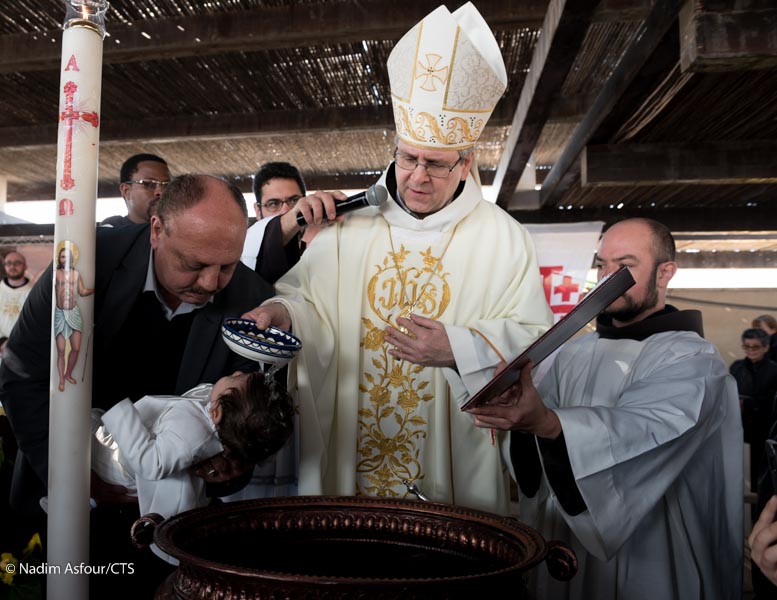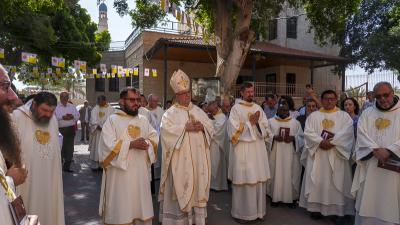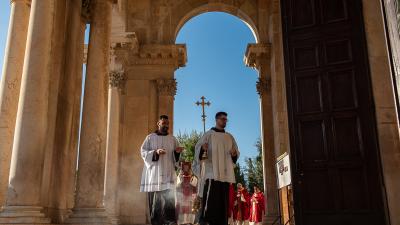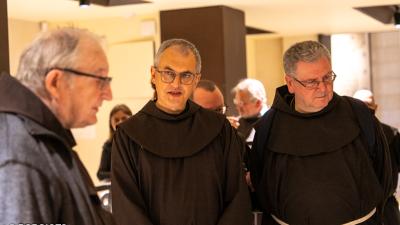
From Bethlehem to the Jordan River: this is how the Christmas holidays came to an end for the friars of the Custody of the Holy Land. This year, the first Sunday after Epiphany fell on January 7, which coincided with the day that the solemnity of the Lord’s Baptism was celebrated. The heat and the strong sun on the banks of the Jordan River did not seem wintry, when the long procession reached the river. The area today is partially closed, due to the presence of mines that have to be removed, but access to the river is still safe.
As per tradition, however, before processing to the Jordan River, the friars of the Custody and the parishioners of Jerusalem stopped in Jericho at the garden of the Terra Santa School. The Custos of the Holy Land met with the local authorities there, the mayor of Jericho and the sheikh. “As you have recalled, Jesus passed through this city many times,” said Fr. Patton. “And like him, this year many pilgrims have also passed through this place. On the occasion of this feast today,” he added, “we want to celebrate the baptism of Jesus and pray for the welfare of all of the people of Jericho, for the prosperity of this city and for peace.” The Custos recalled that Jericho is an exemplary place for cooperation between the local community and the Franciscans of the Custody, and that the friars are well liked by all. Br. Mario Hadchity, the superior in Jericho, translated for the Custos.
Hundreds of people were already waiting in the early morning on the banks of the Jordan River. After the procession, mass was celebrated outside in front of the river. “It happened in those days that Jesus came from Nazareth of Galilee and was baptized in the Jordan by John” was proclaimed in the Gospel reading (Mark 1:9). It was also a day of great joy because of the baptism of little Matthias, the son of a local couple.
“Today we have a special occasion to remind us that through our baptism we become children of God,” said Fr. Patton. In his homily in Arabic, Br. Mario spoke about John the Baptist and Jesus. Jesus was a friend of the one who baptized him. This is why Br. Mario insisted that “we must ask ourselves about friendship and whether or not we are true friends.” Moreover, as John recognized that Jesus was stronger than him, “we must [also] recognize Jesus and get to know him, because we do not follow people we do not know.” The whole homily itself was an examination of conscience following the example of John and Jesus. “John recognized himself, unlike many who wish to imitate others. Jesus does not want this, but we [must] present ourselves as we really are with our limitations,” said the friar.
Among those present were many parish groups, nuns and pilgrims. A woman from Ramallah explained that since she had never attended the celebration, and she took the opportunity to do so this year. “It was a beautiful celebration that I shared with my whole family,” said her mother, as she placed her grandson in a stroller. “It touched me deeply to celebrate this feast here in the Holy Land, on the Jordan River. I could almost imagine Jesus and John here in these waters. But I would not have imagined the joy I had coming here,” said a pilgrim.
On the same day, immediately after leaving the Jordan River, the parishioners and friars went to the Greek-Orthodox Monastery of the Temptation. In that desert landscape, in front of that extraordinary panoramic view, Jesus, according to tradition, was tempted by the devil. Thus the beginning of Jesus’ ministry was recalled, along with his baptism, John’s recognition and the devil’s temptations, which Jesus resisted.
The friars read the Gospel passage of the temptations in different languages and then had a moment of personal prayer. This was a new pilgrimage to thus walk where Jesus lived 2,000 years ago and to [be reminded] that even today we can continue to walk on the path that He showed us.
Beatrice Guarrera




